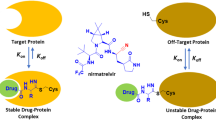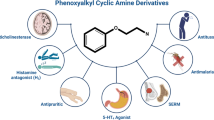Abstract
In our search for novel small molecules targeting histone deacetylases, we have designed and synthesized a series of novel hydroxamic acids incorporating indole moiety as a cap group (3a–l). Biological evaluation showed that these hydroxamic acids potently inhibited HDAC2 with IC50 values in submicromolar range and up to tenfold (compound 3j) better than that of SAHA (also known as suberoylanilide hydroxamic acid). In four human cancer cell lines [SW620 (colon), PC-3 (prostate), AsPC-1 (pancreatic), NCI-H23 (lung)], the synthesized compounds that exhibited potent cytotoxicity with several compounds (3k, 3l) were found to be 12- to 77-fold more cytotoxic than SAHA. Docking experiments indicated that the compounds tightly bound to HDAC2 at the active binding site with binding affinities much higher than that of SAHA. Our present results demonstrate that these novel hydroxamic acids are potential for further development as anticancer agents.






Similar content being viewed by others
References
Bolden JE, Peart MJ, Johnstone RW (2006) Anticancer activities of histone deacetylase inhibitors. Nat Rev Drug Discov 5:769–784. doi:10.1038/nrd2133
Bracker TU, Sommer A, Fichtner I, Faus H, Haendler B, Hess-Stumpp H (2009) Efficacy of MS-275, a selective inhibitor of class I histone deacetylases, in human colon cancer models. Int J Oncol 35:909–920. doi:10.3892/ijo_00000406
Cheng YC (2015) Beware of docking! Trends Pharmacol Sci 36:78–95. doi:10.1016/j.tips.2014.12.001
Cheng T, Grasse L, Shah J, Chandra J (2015) Panobinostat, a pan-histone deacetylase inhibitor: rationale for and application to treatment of multiple myeloma. Drugs Today (Barc) 51:491–504. doi:10.1358/dot.2015.51.8.2362311
Dallavalle S, Cincinelli R, Nannei R, Merlini L, Morini G, Penco S, Pisano C, Vesci L, Barbarino M, Zuco V, De Cesare M, Zunino F (2009) Design, synthesis, and evaluation of biphenyl-4-yl-acrylohydroxamic acid derivatives as histone deacetylase (HDAC) inhibitors. Eur J Med Chem 44:1900–1912. doi:10.1016/j.ejmech.2008.11.005
De Ruijter AJM, Gennip AHV, Caron HN, Kemp S, Kuilenburg ABPV (2003) Histone deacetylases (HDACs): characterization of the classical HDAC family. Biochem J 370:737–739. doi:10.1042/BJ20021321
Glaser KB (2007) HDAC inhibitors: clinical update and mechanism-based potential. Biochem Pharmacol 74:659–671. doi:10.1016/j.bcp.2007.04.007
Hamm CA, Costa FF (2015) Epinomes as therapeutic targets. Pharmacol Ther 151:72–86. doi:10.1016/j.pharmthera.2015.03.003
Huang S-Y, Zou X (2010) Advances and challenges in protein-ligand docking. Int J Mol Sci 11:3016–3034. doi:10.3390/ijms11083016
Huong TTL, Dung DTM, Huan NV, Cuong LV, Hai PT, Huong LTT, Kim J, Kim YG, Han SB, Nam NH (2017) Novel N-hydroxybenzamides incorporating 2-oxoindoline with unexpected potent histone deacetylase inhibitory effects and antitumor cytotoxicity. Bioorg Chem. doi: 10.1016/j.bioorg.2017.02.002 (in press)
Iyer SP, Foss FF (2015) Romidepsin for the treatment of peripheral T-cell lymphoma. Oncologist 20:1084–1091. doi:10.1634/theoncologist.2015-0043
Khandelwal A, Lukacova V, Comez D, Kroll DM, Raha S, Balaz S (2015) A combination of docking, QM/MM methods, and MD simulation for binding affinity estimation of metalloprotein ligands. J Med Chem 48:437–447. doi:10.1021/jm049050v
Lauffer BE, Mintzer R, Fong R, Mukund S, Tam C, Zilberleyb I, Flicke B, Ritscher A, Fedorowicz G, Vallero R, Ortwine DF, Gunzner J, Modrusan Z, Neumann L, Koth CM, Lupardus PJ, Kaminker JS, Heise CE, Steiner P (2013) Histone deacetylase (HDAC) inhibitor kinetic rate constants correlate with cellular histone acetylation but not transcription and cell viability. J Biol Chem 288:26926–26943. doi:10.1074/jbc.M113.490706
Li J, Li G, Xu X (2013) Histone deacetylase inhibitors: an attractive strategy for cancer therapy. Curr Med Chem 20:1858–1886. doi:10.1074/jbc.M113.490706
Malini G (2015) HDAC inhibitors still need a home run, despite recent approval. Nat Rev Drug Discov 14:225–226. doi:10.1038/nrd4583
Nam NH, Parang K (2003) Current targets for anticancer drugs discovery. Curr Drug Targets 4:159–179. doi:10.2174/1389450033346966
Nam NH, Lee C-W, Hong D-H, Kim H-M, Bae K-H, Ahn B-Z (2003) Antiinvasive, antiangiogenic and antitumour activity of Ephedra sinica extract. Phytother Res 17:70–76. doi:10.1002/ptr.901
Nam NH, Huong TL, Dung DTM, Oanh DTK, Dung PTP, Quyen D, Kim KR, Han BW, Kim YS, Hong JT, Han SB (2013) Novel isatin-based hydroxamic acids as histone deacetylase inhibitors and antitumor agents. Eur J Med Chem 70:477–486. doi:10.1016/j.ejmech.2013.10.045
Nam NH, Huong TL, Dung DTM, Oanh DTK, Dung PTP, Kim KR, Han BW, Kim YS, Hong JT, Han SB (2014) Synthesis, bioevaluation and docking study of 5-substitutedphenyl-1,3,4-thiadiazole-based hydroxamic acids as histone deacetylase inhibitors and antitumor agents. J Enzyme Inhib Med Chem 29:611–618. doi:10.1016/j.ejmech.2013.10.045
Oanh DTK, Hai HV, Hue VTM, Park SH, Kim HJ, Han BW, Kim HS, Hong JT, Han SB, Nam NH (2011) Benzothiazole-containing hydroxamic acids as histone deacetylase inhibitors and antitumor agents. Bioorg Med Chem Lett 21:7509–7512. doi:10.1016/j.bmcl.2011.07.124
Pelzel HR, Schlamp CL, Nickells RW (2010) Histone H4 deacetylation plays a critical role in early gene silencing during neuronal apoptosis. BMC Neurosci 11:62. doi:10.1186/1471-2202-11-62
Qiu T, Zhou L, Zhu W, Wang T, Wang J, Shu Y, Liu P (2013) Effects of treatment with histone deacetylase inhibitors in solid tumors: a review based on 30 clinical trials. Future Oncol 9:255–269. doi:10.2217/fon.12.173
Ramírez D, Caballero J (2016) Is it reliable to use common molecular docking methods for comparing the binding affinities of enantiomer pairs for their protein target? Int J Mol Sci 17:E525. doi:10.3390/ijms17040525
Schuttelkopf AW, van Aalten DM (2004) PRODRG: a tool for high-throughput crystallography of protein-ligand complexes. Acta Crystallogr D Biol Crystallogr 60:1355–1363. doi:10.1107/S0907444904011679
Skehan P, Storeng R, Scudiero D, Monk A, MacMahon J, Vistica D, Warren JT, Bokesch H, Kenney S, Boyd MR (1990) New colorimetric cytotoxicity assay for anticancer drug screening. J Natl Cancer Inst 82:1107–1112. doi:10.1093/jnci/82.13.1107
Trott O, Olson AJ (2010) AutoDock Vina: improving the speed and accuracy of docking with a new scoring function, efficient optimization, and multithreading. J Comput Chem 31:455–461. doi:10.1002/jcc.21334
Tung TT, Oanh DT, Dung PT, Hue VT, Park SH, Han BW, Kim Y, Hong JT, Han SB, Nam NH (2013) New benzothiazole/thiazole-containing hydroxamic acids as potent histone deacetylase inhibitors and antitumor agents. Med Chem 9:1051–1057. doi:10.2174/15734064113099990027
Valente S, Mai A (2014) Small-molecule inhibitors of histone deacetylase for the treatment of cancer and non-cancer diseases: a patent review (2011–2013). Expert Opin Ther Pat 24:401–415. doi:10.1517/13543776.2014.877446
Vanommeslaeghea K, Loverixb S, Geerlings P, Tourwéa D (2005) DFT-based ranking of zinc-binding groups in histone deacetylase inhibitors. Bioorg Med Chem 13:6070–7082. doi:10.1016/j.bmc.2005.06.009
Ververis K, Hiong A, Karagiannis TC, Licciardi PV (2013) Histone deacetylase inhibitors (HDACIs): multitargeted anticancer agents. Biologics 7:47–60. doi:10.2147/BTT.S29965
West AC, Johnstone RW (2014) New and emerging HDAC inhibitors for cancer treatment. J Clin Investig 124:30–39. doi:10.1172/JCI69738
Witt O, Deubzer HE, Milde T, Oehme I (2009) HDAC family: what are the cancer relevant targets? Cancer Lett 277:8–21. doi:10.1016/j.canlet.2008.08.016
Wu L, Smythe AM, Stinson SF, Mullendore LA, Monks A, Scudiero DA, Paull KD, Koutsoukos AD, Rubinstein LV, Boyd MR, Shoemaker RH (1992) Multidrug-resistant phenotype of disease-oriented panels of human tumor cell lines used for anticancer drug screening. Can Res 52:3029–3034. doi:10.1016/j.canlet.2008.08.016
Wu R, Lu Z, Cao Z, Zhang Y (2011) Zinc chelation with hydroxamate in histone deacetylases modulated by water access to the linker binding channel. J Am Chem Soc 133:6110–6113. doi:10.1021/ja111104p
Ye G, Nam NH, Kumar A, Saleh A, Shenoy DB, Amiji MM, Lin X, Sun G, Parang K (2007) Synthesis and evaluation of tripodal peptide analogues for cellular delivery of phosphopeptides. J Med Chem 50:3604–3617. doi:10.1021/jm070416o
You YJ, Kim Y, Nam NH, Ahn BZ (2003) Antitumor activity of unsaturated fatty acid esters of 4′-demethyldeoxypodophyllotoxin. Bioorg Med Chem Lett 13:2629–2632. doi:10.1016/S0960-894X(03)00558-4
Zwergel C, Valente S, Jacob C, Mai A (2015) Emerging approaches for histone deacetylase inhibitor drug discovery. Expert Opin Drug Discov 10:599–613. doi:10.1517/17460441.2015.1038236
Acknowledgements
We acknowledge the principal financial supports from the National Foundation for Science and Technology of Vietnam (NAFOSTED, Grant Number 104.01-2015.08). This work was also partly supported by the Grant Number 104.01-2014.55 (from NAFOSTED), the Korean Medical Research Center program (Grant Number 2008-0062275), and a small Grant from Hanoi University of Pharmacy.
Author information
Authors and Affiliations
Corresponding authors
Ethics declarations
Conflict of interest
The authors report no conflict of interest.
Electronic supplementary material
Below is the link to the electronic supplementary material.
Rights and permissions
About this article
Cite this article
Huong, T.T.L., Van Cuong, L., Huong, P.T. et al. Exploration of some indole-based hydroxamic acids as histone deacetylase inhibitors and antitumor agents. Chem. Pap. 71, 1759–1769 (2017). https://doi.org/10.1007/s11696-017-0172-1
Received:
Accepted:
Published:
Issue Date:
DOI: https://doi.org/10.1007/s11696-017-0172-1




